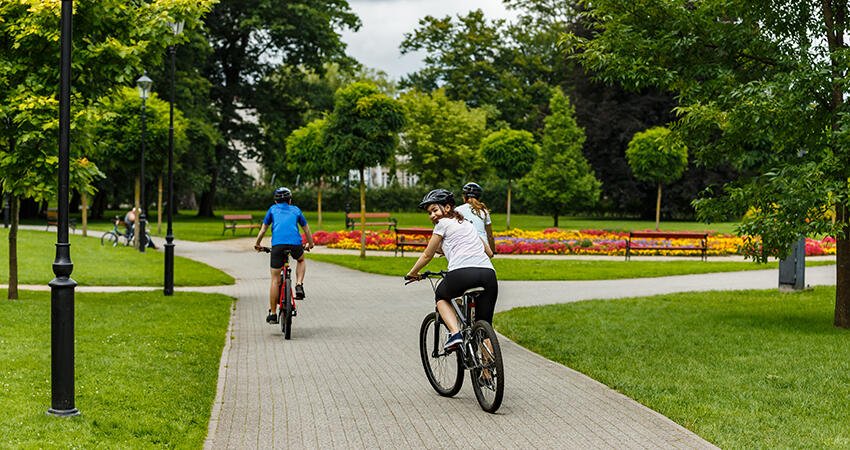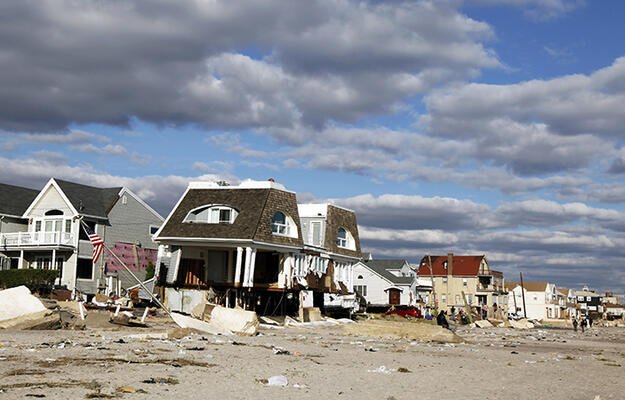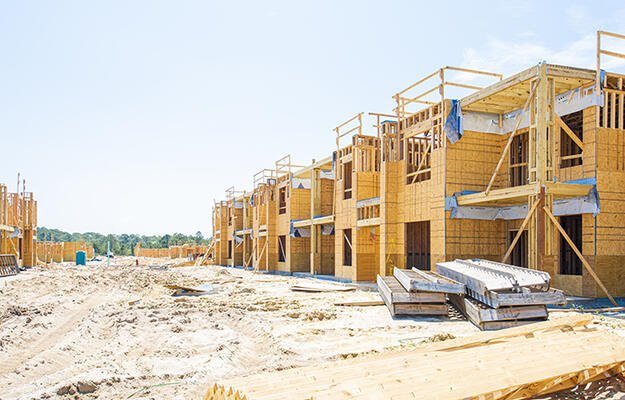
(Jacek Chabraszewski/Shutterstock)
Centering Community Ownership and Voice to Combat Green Gentrification
Having access to a park or green space minutes away from home can be an immense asset for people and their communities. Nearby residents enjoy using these public spaces for walking, hiking, playing, and relaxing. Plus, they may experience improvements to physical and mental health and feel connected to their community and neighbors.
Public and private housing developers value the benefits parks and green spaces add to an area because they drive economic development and transform neighborhoods. However, by contributing to increasing property values, these green amenities can also present risks for lower-income residents, pricing them out of their neighborhoods. This phenomena is known as green gentrification and can be an unintended consequence of park and green space development. Considering and taking appropriate steps to manage and mitigate this risk is critical for ensuring all residents have equitable access to parks and housing stability.
Affordable housing developers must consider this risk when promoting green investments. Some scholars recommend “just green enough” strategies, which limit the scale and scope of park and green space investments to avoid larger, more publicized park projects that might contribute to nearby displacement. But others counter that this approach reinforces inequities by denying lower-income residents the opportunities to unlock the maximum potential of green assets. People of color and residents with low incomes often already suffer from a lack of investment in community parks and therefore miss out on many of the benefits of living close to a quality park or green space.
To make the case for investing in green amenities, park professionals and housing developers seek to demonstrate the economic contributions. This is often done through hedonic modeling, but it does not account for resident displacement and the ways greening can perpetuate income and racial inequities.
Park investments must be coupled with antidisplacement strategies to effectively provide equitable housing and greening opportunities that benefit all residents. Further, these strategies need to be hyperlocal and address the residents’ needs on the neighborhood, and sometimes the block, level.
Here are three ways cities can mitigate unintended consequences of green gentrification while capturing the benefits of investing in large-scale parks and green spaces.
1. Enhance neighborhood stability through community land trusts (CLTs) and comprehensive equitable development plans.
Since 2005, community-based organization Building Bridges Across the River (BBAR) has worked with families living east of the Anacostia River in Washington, DC, to combat the severe social, health, environmental, and economic disparities experienced by Black residents of southeast DC. In 2015, the city and BBAR announced plans to replace the 11th Street Bridge, which connects the Capitol Hill and Anacostia neighborhoods, with the city’s first elevated green space. The 11th Street Bridge Park, built on the foundations of the old bridge and adjacent to the new bridge, will include outdoor performance spaces, playgrounds, urban agriculture, an environmental education center, and public art.
Because of both DC’s intense gentrification and the notable income and racial differences between Anacostia and Capitol Hill, residents were concerned park investments would lead to them getting displaced or becoming homeless. Over two years, through a multistakeholder partnership, BBAR held more than 200 meetings for residents to develop and give feedback on an equitable development plan, which led to the creation of the Douglass Community Land Trust.
Douglass CLT uses community ownership to preserve and expand affordable housing, both preventing developers from displacing low-income residents and ensuring current residents can benefit from the investments in 11th Street Bridge Park. Further, the presence of a strong CLT helps capture the economic value generated from the park for residents.
For communities at high risk of gentrification, moving housing from market ownership to community ownership via a CLT can be a powerful tool for ensuring green investments benefit long-term residents and to stave off fears of displacement. And comprehensive equitable development plans help lay a clear path and vision for antidisplacement measures, whether land is community-owned or not. But because these plans often lack regulatory teeth or accountability measures, planners must consider how to ensure equitable development plans are actionable guides, rather than abstract ideals.
2. Include residents’ priorities in joint housing and green investments.
Municipalities often attempt to coordinate housing investments with other types of investments, such as transportation and parks. However, local government efforts to align housing plans with green investment are not always successful at improving equity. The High Line Park in New York was a large-scale effort to repurpose an elevated rail track into green space for Manhattan residents and visitors. When originally earmarked for demolition, the community advocated for adaptive reuse and were invited by the city to participate in its transformation plan. However, the city made zoning changes (PDF) in the area around the park while the park was getting built that did not incorporate this participation. These zoning changes ushered in rapid development that resulted in thousands of new luxury units and in a demographic shift, in which the High Line Park became an attraction for white, wealthy residents and tourists, even though the community helped contribute to the design.
To avoid this, evidence suggests the community members around the High Line and other park projects of varying scales should be engaged in more than just design decisions. A study of several greening without gentrification practices across the US found that housing developers who actively engage residents can meaningfully mitigate the threat of displacement. The study recommends early stage, deliberate community engagement that includes residents, business owners, park organizations, and housing organizations. One example of this work in practice is by the Los Angeles Regional Open Space and Affordable Housing (LA ROSH) collaborative to ensure there is a variety of outreach done for all park-funded work, materials in multiple languages, and different methods of engagement through the park scoping and development process. Most importantly, LA ROSH budgets for community engagement activities in their park investment allocations.
Involving communities throughout the park planning and implementation process creates opportunities for parks investments to bolster existing movements for affordable housing, community-controlled land uses, and resource redistribution back to community members. And this community engagement must be initiated at the outset of project planning and maintained throughout the life cycle of the park.
3. Use state and local policy levers to mitigate displacement pressures and build parks and affordable housing.
Several cities have instituted tax policies to provide relief from steep, gentrification-induced rises in property assessments. In Philadelphia, for example, the Longtime Owner Occupants Program limits home assessment increases to 50 percent for those who have lived in their residence for 10 or more years and meet an income cap. This policy “[helped] mitigate the risk of tax delinquencies and residential displacement.” Some states have also implemented “circuit breaker” state income tax policies that provide relief for low-income homeowners faced with high property tax bills, such as in the event of neighborhood gentrification.
Where feasible and allowed by law, tax policy can also be harnessed to generate dedicated revenue for parks and green space and affordable housing. For instance, Seattle raises revenue for parks in part from a real estate excise tax and a voter-approved park taxing district (PDF). And a number of states have implemented real estate transfer taxes on high value properties, some of which use the revenue explicitly for affordable housing.
Perhaps the most comprehensive local policy at the intersection of parks, housing, and displacement is Los Angeles County’s Displacement Avoidance Policy, passed by voters in 2019 as part of a countywide parcel tax for parks and open space. Among the provisions of this policy is encouragement for park agency and nonprofit park developers to collaborate with affordable-housing developers, as well as incentives to incorporate displacement avoidance strategies in park development projects. Cities can consider coupling dedicated tax programs with antidisplacement measures to provide affordable housing while mitigating the consequences of green gentrification. For instance, using land value capture or developing a community land trust can harness the increased value of the land for green investment and keep the housing affordable and residents stably housed as their neighborhood improves. These are bottom-up policies and practices to center residents and their needs in the investment opportunity.


